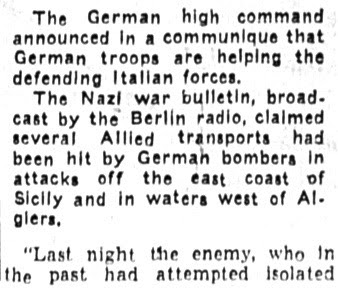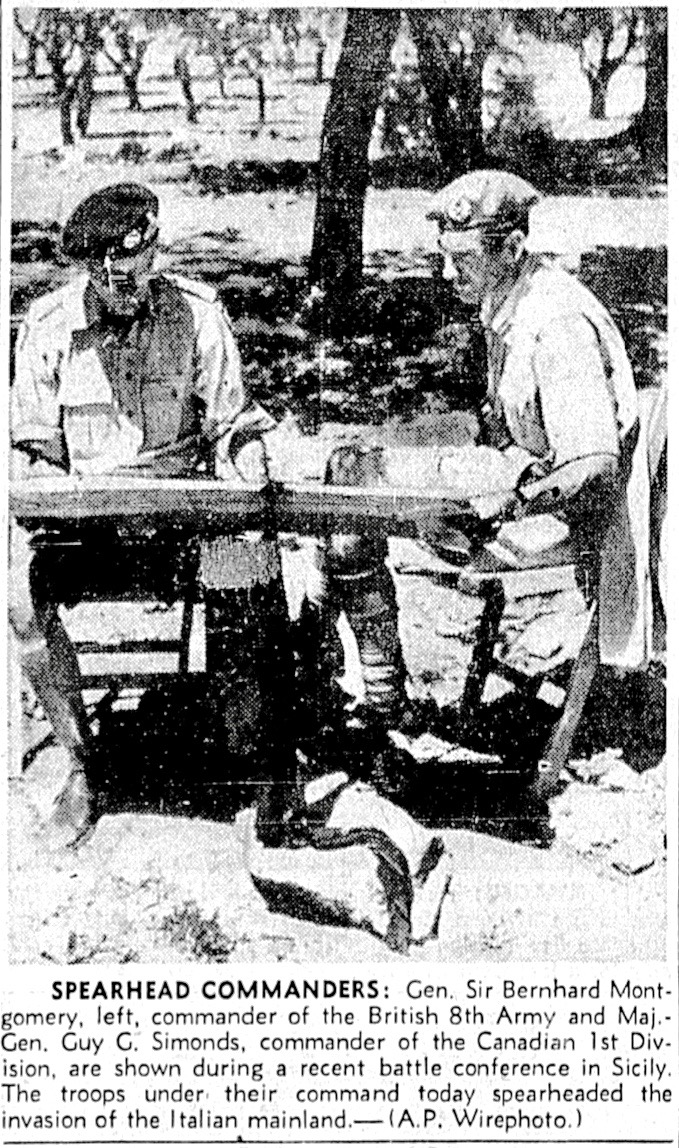The Invasion of The Toe of Italy's Boot, Beginning Sept. 3, 1943
Articles, Context from The Winnipeg Tribune, Sept. 3, '43
Headline on the day's 2nd edition. The Trib boasted 'up-to-the-minute' news
Introduction:
The EXTRA morning edition shared the first news with Canadians related to Operation Baytown (without ever mentioning the actual name of the invasion plans or operation), D-Day Sept. 3, 1943, at Reggio di Calabria, and surrounding areas on Italy's Toe.
Other operations were planned as well: Operation Avalanche would be the most difficult Allied landing on Italy's mainland at Salerno (a bit south of Naples), D-Day Sept. 9 on Italy's shin; Allied troops would soon land at Taranto, Italy's heel as well. So, more invasion news will be forthcoming. Stay tuned : )
Before the sun sets on Italy's toe, however, please find below news clippings from The Winnipeg Tribune (digitized) re a very significant D-Day involving not only Monty's Eighth Army but the Canadian First Division and many Canadians in RCNVR and Combined Operations aboard the 80th Flotilla of Landing Crafts (landing crafts, mechanised, aka LCMs).
The invasion forces crossed the Straits of Messina from a number of ports and coves and landed at Reggio and other towns, ports and beaches, e.g., Scilla and Melito. Once boots were on the ground, machines and fuel and guns and ammunition (and all other materials of war) followed in their wake in order to establish well-supplied beachheads.
Reggio, Taranto and Salerno can be seen on the illustration above.
Credit - Eclipse page 32, by A. Moorehead
News reports and photographs are from The Tribune (digitized) unless otherwise stated:
Above we read, "There was no mention of American ground forces taking part in the amphibious attack."
The American Fifth Army, commanded by Gen. Mark Clark, would be much in the news beginning on D-Day September 9 at Salerno
In other paragraphs in the above report we read a few words about a Rome communique telling how German aircraft were effective against Allied convoys and "shipping in the roadsteads at Catania and Augusta," but that might be either false or a delayed report from a few days earlier.
My father writes about seeing German aircraft in one particular harbour in the days before the invasion at Reggio:
At night we watched German planes try to take evasive action as they were caught in the searchlights which circled the harbor. During the day we could see the smoke from Mt. Etna.
Just after dark that night, September 3rd, we left the beach to join our appointed convoy of LCI's, LCT's and LCA's. This convoy was passing at a certain time close inshore but it was like a game of hide and seek to find them. This done, we proceeded up the coast to Mili Marina, where our particular boat was to pick up a Canadian Brigadier and his HQ staff.
Page 113, "Dad, Well Done"
Though he may have started transporting goods and machines on an LCM out of Mili Marina, he eventually moved to a bombed out house (w no roof) north of Messina, as did many other Canadian sailors.
A Canadian LCM Flotilla Engineer officer recounts the following re D-Day Sept. 3:
The beaches along this part of the coast are paradise for landing craft with about a five to one slope, and were well marked with distinguishing lights. The time set for the final stage of the trip was 0300 (3:00AM). We knew the plan was to lay down a heavy artillery barrage from the island across the Straits of Messina.
Just as we turned from the coast to proceed due east to the Italian toe, the barrage opened up. And what a deafening roar! It was magnificent to say the least, and even a quarter of a mile off-shore we could feel the concussion from the guns. By the time we reached mid-channel a fog was settling down and this was turned into a good imitation of London's foggiest weather by the smoke from the exploding shells as we neared the coast. Navigation was difficult, but we managed to keep on the stern of our guiding M.L. (Motor Launch)
With all the racket, plus a general expectation of a heavily opposed landing we expected to hear enemy guns opening up at any minute. Nothing happened - we crept in closer - still nothing but the pounding of our own guns, then one of the Brigadier's wireless sets began to pick up messages. "Red beach unopposed" and later, "Green beach unopposed"! By this time we were able to dimly see the outlines of the hills through the smoke and fog.
Coming closer still, we could see the troops of the initial wave walking along the beach. By this time invasion craft of every description were milling about. What a sight! On the beach, while the troops were unloading, gay banter could be heard from the boats' crews. And so easy was the first permanent invasion of Europe!
How true Churchill's words proved, "We shall strike the soft under-belly of Europe!" Nowhere on the toe were the landings opposed by a single shot, nor was a single enemy plane in sight overhead. But there were planes, ah yes, the faithful Spitfires droned reassuringly as dawn broke.
This was but the initial landing in Italy.
This was but the initial landing in Italy.
Our next job was to act as ferry service across the Straits to keep a steady stream of vehicles and supplies to Monty's Men. This was first done from Teressa*(sic) and later from beaches north of the Messina harbour. In the latter place we were able to billet the Flotilla in houses close to the beaches.
*Santa Teresa di Riva, about 10 miles south of Messina


Page 100, Combined Operations by C. Marks, London ONT
Distance from north of Messina to Reggio is approx. 7 miles, one way
Readers - please note the last line above. The photo is from
Operation Husky, beginning July 10, 1943
The following photo, from another inline source, reveals Canadian troops coming to shore at Reggio di Calabria on September 3rd. Operation Baytown, Italy.
The Royal 22 Regiment landing on the beach at Reggio
di Calabria on the morning of September 3, 1943
Photo Credit - Italia 1943 altervista
Readers, please note that the above photo does not reveal the Allied army leaders
meeting on beaches of the Italian mainland, on Sept. 3rd or thereafter.
Perhaps before the Army leaders sat down for lunch at Reggio di Calabria (on the day of invasion or shortly thereafter*), a few hearty members of the 80th Flotilla of Landing Crafts (RCNVR and Combined Operations) beat them to the picnic table first!
"First lunch on mainland Italy. Men of the 80th LCM Flotilla" Photo - Ed Corbett,
found in St. Nazaire to Singapore: Canadian Amphibious War, Vol. 1, pg 192
[*In St. Nazaire to Singapore: Volume 1, Ed Corbett's diary reveals he was on mainland Italy at least by Sept. 4th. Please see Part 5 of this series.]
News from The Winnipeg Tribune continues:
Future accounts re "Landings At Other Points," e.g., Taranto and Salerno, will be found on this site as well:
Future accounts re "Landings At Other Points," e.g., Taranto and Salerno, will be found on this site as well:
Taranto (heel) and Salerno (south of Naples, shin) can be found above
Over the 'Southern Wall' we go, Boys!
The heading on the next article may remind readers of some of P.M. Churchill's well-known words:
An informative editorial follows:
It is my understanding that Ross Munro, well-known Canadian war correspondent, landed at Reggio aboard an Allied landing craft (manned by Canadian sailors?) and his first report will be listed on this site asap, if it can be found:


Although the following article was on Page 1, just left of the major headline, I have left it 'til the end because of its good "sum up' for the invasion day:
More news and views will soon be forthcoming from The Winnipeg Tribune and Navy memoirs.
Please link to Editor's Research: Operation Baytown (Italy WWII) (4a)
Unattributed Photos GH



































No comments:
Post a Comment